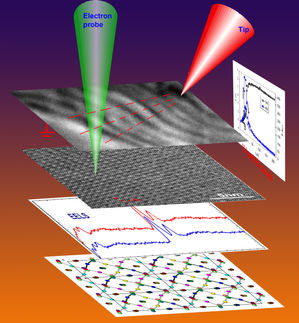SALVE Project Enters Second Phase
Successful evaluation phase prompts University of Ulm and Carl Zeiss to continue with their joint venture to develop a high-performance transmission electron microscope
Following the successful completion of a two-year evaluation phase, the University of Ulm, the Heidelberg-based company CEOS GmbH and Carl Zeiss Nano Technology Systems have signed an agreement to embark on the next phase of the SALVE project. SALVE – which stands for Sub-Angstrom Low Voltage Electron Microscope – is one of the most ambitious research projects in the field of electron microscopy to be undertaken in Germany in recent years. The objective of the project is to develop and build a transmission electron microscope capable of imaging samples with atomic resolution at very low acceleration voltages. The researchers are also aiming to develop suitable sample preparation methods. The advantages offered by this approach are clear: Unlike the current generation of medium-voltage TEMs with accelerating voltages of between 200 and 300 kV, which destroy radiation-sensitive samples before researchers can record usable images or perform material analysis, the SALVE project will keep specimens stable long enough to perform experimental work. Implementation of this tantalizing concept was previously seen as impossible due to the physical and technical hurdles that stood in the way of achieving the required resolution, because lower accelerating voltages lead to significant optical aberrations.
However, the first phase of the cooperation project conducted between 2009 and 2011 – in which researchers analyzed the feasibility of the key principles involved – has produced some spectacular results, with the scientists successfully generating atomic-resolution images at accelerating voltages well below 80 kV. Based on this initial success, the German Research Foundation (DFG) and the Ministry for Science, Research and Art form the Federal State of Baden-Wuerttemberg (MWK/BW) support the SALVE project in its second phase with 3.2Mio € (DFG) and 2.1 Mio € (MWK/BW).
During celebrations to mark the start of the project’s second phase, Project Manager Professor Ute Kaiser from the University of Ulm and a number of guest speakers, including Nobel Prize winner Klaus von Klitzing, presented some of the fascinating ways in which the SALVE system could potentially be used. Ranging from studies of superconductors and semiconductors to research into lithium-ion batteries, plastics and biological materials, some of the examples they highlighted have already yielded preliminary results.
Carl Zeiss NTS General Manager Dr. Peter Fruhstorfer was enthusiastic about the new phase of the project: “Low-voltage electron microscopy is a fast-growing field of application for transmission electron microscopy, largely due to the properties of modern materials, such as their size, form and sensitivity to radiation. We are greatly looking forward to tackling the challenging task of developing solutions in this area.” He also stressed how SALVE will give the companies involved a significant competitive edge.
While Carl Zeiss presses ahead with development of the system itself, the University of Ulm will be working on application development and conducting research into sample preparation methods. Meanwhile, the third project partner, CEOS, having a lot of expertise in the development of advanced electron optical systems, is focusing its efforts on a new optimized corrector to compensate the chromatic and the spherical aberration for low voltages.
Topics
Organizations
Other news from the department science

Get the analytics and lab tech industry in your inbox
By submitting this form you agree that LUMITOS AG will send you the newsletter(s) selected above by email. Your data will not be passed on to third parties. Your data will be stored and processed in accordance with our data protection regulations. LUMITOS may contact you by email for the purpose of advertising or market and opinion surveys. You can revoke your consent at any time without giving reasons to LUMITOS AG, Ernst-Augustin-Str. 2, 12489 Berlin, Germany or by e-mail at revoke@lumitos.com with effect for the future. In addition, each email contains a link to unsubscribe from the corresponding newsletter.


























































